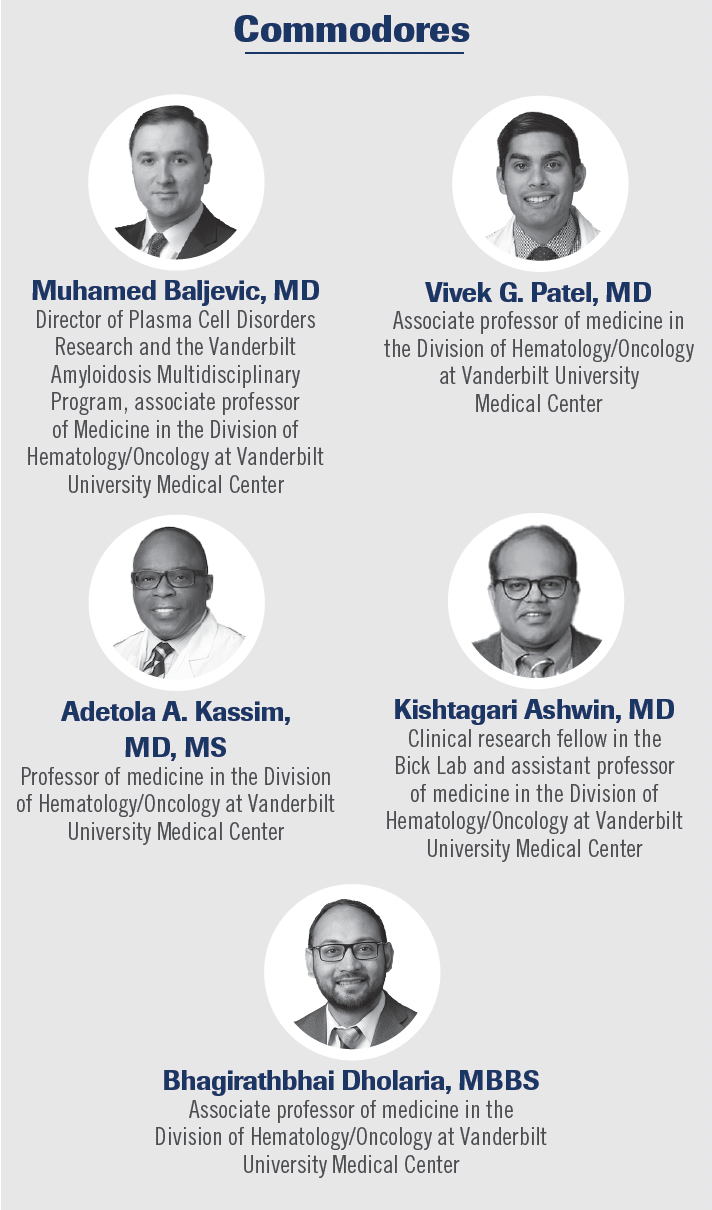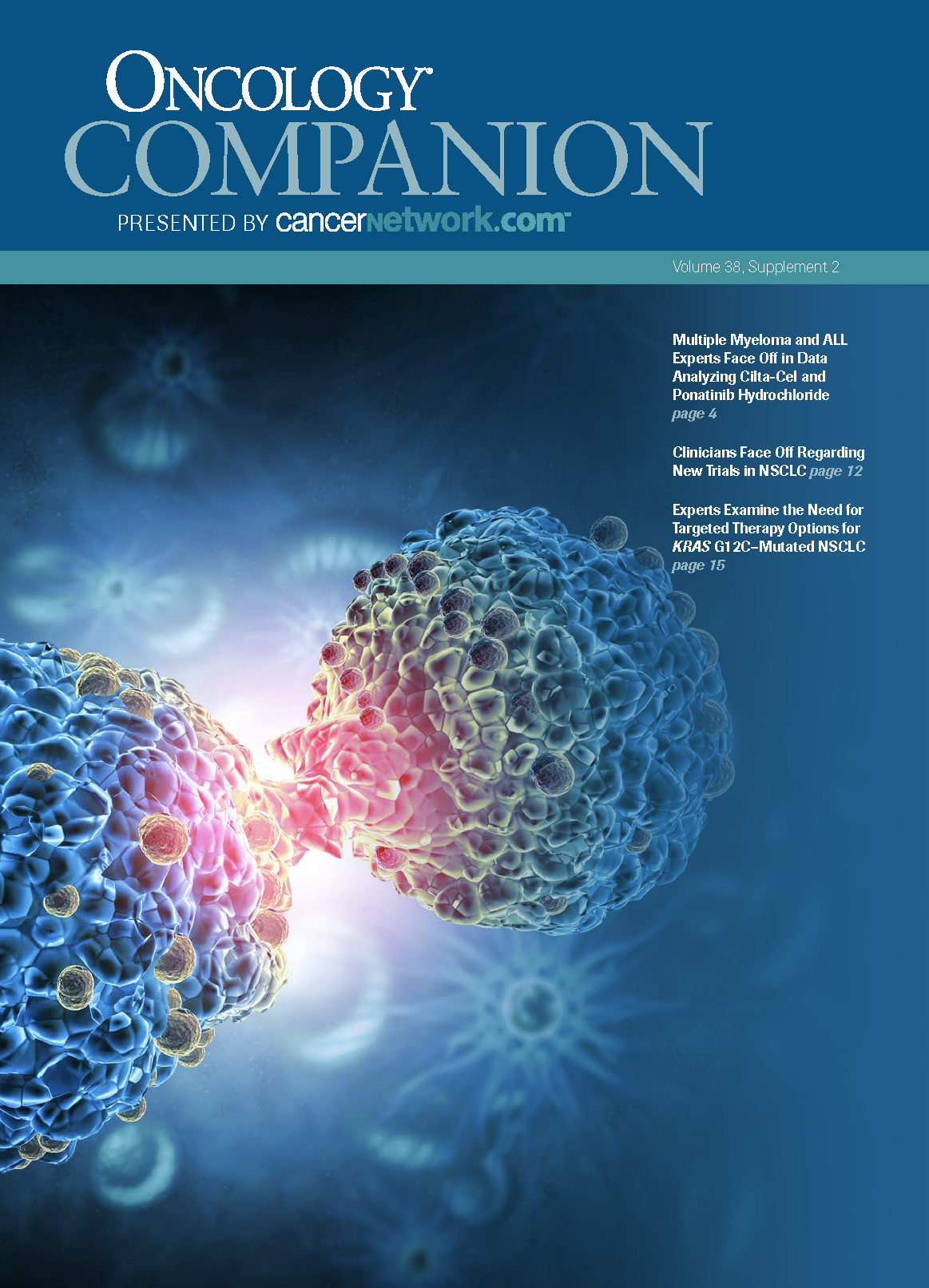Multiple Myeloma and ALL Experts Face Off in Data Analyzing Cilta-Cel and Ponatinib Hydrochloride
Vanderbilt University Medical Center and Winship Cancer Institute at Emory University Face Off on recent data in multiple myeloma and acute lymphoblastic leukemia.
Commodores

Eagles

In a recent Face-Off program hosted by CancerNetwork®, experts from Vanderbilt University Medical Center (the Commodores) and the Winship Cancer Institute at Emory University (the Eagles) went head-to-head to discuss recent data in multiple myeloma and acute lymphocytic leukemia (ALL). The panelists discussed the data from various trials in the space and highlighted different treatment combinations for patients with multiple myeloma or ALL.
CARTITUDE-4 Trial
The phase 3 CARTITUDE-4 trial (NCT04181827) included patients with multiple myeloma refractory to lenalidomide (Revlimid).1 A total of 419 patients were randomly assigned to receive ciltacabtagene autoleucel (cilta-cel; Carvykti; n = 208) or physician’s choice of effective standard care (n = 211). To be eligible, patients must have received 1 to 3 previous lines of treatment and have had measurable disease.
The primary end point of the trial was progression-free survival (PFS). Secondary end points included complete response (CR) rate, overall minimal residual disease (MRD) negative rate, and overall survival (OS).
The median follow-up was 15.9 months. The median duration of PFS was not reached in the experimental arm and was 11.8 months (95% CI, 9.7-13.8) in the standard care arm. The PFS at 12 months was 75.9% (95% CI, 69.4%-81.1%) in the cilta-cel group and 48.6% (95% CI, 41.5%-55.3%) in the standard care group. In the cilta-cel and standard care groups, respectively, 84.6% vs 67.3% experienced an overall response, 73.1% vs 21.8% experienced a CR or better, and 60.6% vs 15.6% experienced an absence of MRD.
A total of 39 patients in the cilta-cel arm and 46 patients in the standard care arm died during the study (HR, 0.78; 95% CI, 0.5-1.20). Among those who received cilta-cel, 76.1% had cytokine release syndrome, 4.5% had immune effector cell–associated neurotoxicity, 9.1% had cranial nerve palsy, and 2.8% had chimeric antigen receptor (CAR) T–cell therapy-related peripheral neuropathy.
The Use of Treatment Combos Before Published Trial Data
Patel: What about all the early deaths that occurred in the beginning for those who waited [for treatment]?
Joseph: In the cilta-cel arm?
Patel: Yes.
Joseph: Of the 208 patients in the cilta-cel arm, only 176 received up-front infusion, [which] was due to disease progression.
Patel: In the real world, when we have single-case agreements, insurance authorization, apheresis slot manufacturing—do you think that would happen in the real world, or do you think it could be worse in the real world than what we saw [in the study]?
Joseph: The challenge is the correct patient selection. You need a patient who can wait, and that’s the same whether [the patient is in the] fourth line or first line [of treatment]. You’re more likely to have a patient who can wait for the first relapse than at the fourth relapse. That’s just the natural history of the disease. Certainly, some patients who are at higher risk are going to require bridging, and bridging was allowed in this trial. Of the 30 patients who were not able to receive cilta-cel up front, two-thirds of those patients received cilta-cel later. If you can have effective bridging therapy, you’re more likely to have effective bridging if the patient’s disease is not so refractory.
Dholaria: I want to get your comment on the control arm. Most patients in the study who were newly diagnosed had immunomodulatory drug [IMiD] exposure, and the control arm only had an IMiD-based triplet. There is no daratumumab [Darzalex] with carfilzomib [Kyprolis] and dexamethasone [Kd] or isatuximab-irfc [Sarclisa] plus Kd in the control arm, which we saw in the phase 3 IKEMA trial [NCT03275285] [that examined] the 3-year PFS [of this drug combination] in relapsed/refractory myeloma.2 If we have a study that allows second-generation hydrolysis-based agent, will the [HR] still be clinically meaningful?
Joseph: That’s a fair point. This [patient population has] 2 to 4 prior lines of treatment. Regardless of [which treatment] you use, we’re still not going to see as good of a response as 3 years. The IKEMA study was 36 months, and that was 1 to 3 prior lines.
Baljevic: Actually, IKEMA was 42 months. You correctly pointed out the better toxicity profile, which is important. However, you pointed out that we don’t have median PFS, but at the rate at which the curve is going, it seems like it’s going to hit below that point. The question then becomes: why should we consider giving somebody CAR T-cell therapy in an early line when [the drug combination] testing in the IKEMA study produced [a] median PFS of 42 months? We know we can salvage somebody successfully [with this drug combination]; we’ve seen that with cilta-cel, we’ve seen that with idecabtagene vicleucel [Abecma], and we see that with bispecifics. Why would we choose to give patients CAR T therapy in an early-line setting and then not know whether we can successfully salvage them with a chemotherapy regimen or any other combinations when we do know we can probably treat patients well if we gave CAR T-cell therapy in a slightly later line?
Nooka: When the study was designed, we didn’t have the phase
3 data to support the daratumumab plus Kd or isatuximab plus Kd [regimens]. It has become so much easier for us to command [the treatments], but when the study was originally initiated, we didn’t have those as standards of care. Now it is essential for us to take into consideration, but talking about why it was not included in the study is a
fair point.
Joseph: Another point to make is that [administering] daratumumab until progression is a lot of therapy as opposed to a one-and-done CAR T. For some patients, it might be preferable to have 1 infusion and 3 years of PFS vs coming in weekly for daratumumab.
Baljevic: All this is correct, but we only have the data when we have it. Now we have greater insight, and this is a general point you can use [regarding] every single trial. The designs of every trial are probably behind the times, and that’s because of the insights and foresight with which we practice in [the myeloma space]. We started using bortezomib [Velcade], lenalidomide [Revlimid], and dexamethasone nearly 8 to 10 years before we had data from the phase 3 SWOG S0777 trial [NCT00644228] that showed us its PFS and its benefit.3
Baljevic: We know the data now. We’re going to see a bunch of isatuximab, carfilzomib, lenalidomide, and dexamethasone combinations in patients with high-risk disease in the frontline setting, and this is powerful stuff. I’m thinking ahead about how we’re going to sequence all these things, because these are the questions we get all the time. I am a little worried about how we will salvage people when we start doing these regimens, where we have no insight on what to
do afterward.
Chemotherapy Plus Ponatinib Hydrochloride
A phase 2 trial (NCT01424982) included 86 patients with Philadelphia chromosome–positive ALL who received chemotherapy in combination with ponatinib (Iclusig) hydrochloride.4 Ponatinib was administered at 45 mg daily for 2 weeks during induction, then administered at 45 mg daily continuously for the first 37 patients or 30 mg daily for the rest of the study population, with dose reductions to 15 mg daily upon complete molecular response. Maintenance therapy consisted of daily ponatinib and vincristine-prednisone monthly for 2 years followed by daily ponatinib indefinitely. The primary end point was event-free survival (EFS). Secondary end points included CR rates, the incidence of grade 3 or
4 adverse effects (AEs), OS, and disease-specific survival.
At the median follow-up of 80 months (range, 16-129), the EFS was 65% (95% CI, 54%-74%) and the OS was 75% (95% CI, 64%-83%); all patients experienced a CR. A total of 23% of patients had to undergo allogeneic stem cell transplant. The cumulative complete molecular response rate was 86%.
Common grade 3 or higher AEs included infection (93%), increase in liver transaminases (31%) and total bilirubin (15%), hypertension (17%), pancreatitis (15%), hemorrhage (13%), and skin rash (10%). Ponatinib-related deaths occurred in 3% of patients due to myocardial infarction in the first 37 patients treated, which led to ponatinib dose modifications. No further ponatinib-related deaths were observed.
The Necessity of Chemotherapy
Patel: The question remains: Do you need hyperfractionated cyclophosphamide, vincristine, doxorubicin, and dexamethasone [hyper-CVAD] as the backbone for chemotherapy treatment?
Vale: [This trial has] a relatively healthy [patient] population, good performance statuses, [and] few cardiovascular comorbidities and still had strikingly high rates of infection—for example, arterial and venous occlusive events and pancreatitis. The question is not [whether] hyper-CVAD is the appropriate chemotherapy to combine with this tyrosine kinase inhibitor [TKI]. [The question is], is chemotherapy necessary, or can we cure [most] of these patients with a chemotherapy-free approach?
Patel: I 100% agree. We’ll get into the data for dasatinib [Sprycel] and blinatumomab [Blincyto], but we also have data from the phase 2 trial assessing ponatinib plus blinatumomab, and these data are very interesting in that none of those patients [had a transplant].5,6 This is different from the dasatinib plus blinatumomab data. What would happen if you didn’t [perform a] transplant [for] the patients? It’s a question that needs to be answered.
Vale: Based on the cyclophosphamide, bortezomib, and dexamethasone [CVd], or the less-intensive chemotherapy,approaches and the immunotherapy approaches, are there still patients [who] you’re treating with hyper-CVAD plus TKI?
Patel: It’s hard right now. We’ve got a bunch of nonrandomized studies from [The University of Texas] MD Anderson [Cancer Center in Houston], and it’s a choose-your-own adventure at this point. You could make an argument to go with the mini-CVd route with ponatinib. I would go with hyper-CVAD plus dasatinib. It’s well tolerated, we have good experience with it, and we don’t have enough data to overturn that right now. Chemotherapy-free approaches sound great, but the cost of therapy and getting the approval is very difficult. I also worry about potentially losing blinatumomab on the back end. I think time will tell with the data, but those would be my concerns.
Vale: It’s interesting that you mentioned that last point. I know there are some emerging data looking at using inotuzumab ozogamicin [Besponsa] for patients with MRD positivity and who’ve been exposed to blinatumomab either in the frontline [setting] or in consolidation. You raised an excellent point, but hopefully we’ll be developing strategies to mitigate that in the future.
Dholaria: There’s a huge selection bias on patients from MD Anderson. Patients travel from all over the world to go to Houston. They have access to CAR T and up-front consolidation there. That’s what they’re doing. If you don’t clear MRD, they’re giving brexucabtagene autoleucel [Tecartus]. That’s not the standard of care anywhere else in the world. You have to be careful when you look at the phase 2 data from there.
The winner for the Eagles vs Commodores Face-Off was determined to be the Eagles!
References
- San-Miguel J, Dhakal B, Yong K, et al. Cilta-cel or standard care in lenalidomide-refractory multiple myeloma. N Engl J Med. 2023;389(4):335-347. doi:10.1056/nejmoa2303379
- Martin T, Dimopoulos MA, Mikhael J, et al. Correction: isatuximab, carfilzomib, and dexamethasone in patients with relapsed multiple myeloma: updated results from IKEMA, a randomized phase 3 study. Blood Cancer J. 2023;13(1):152. doi:10.1038/s41408-023-00923-6
- Durie BGM, Hoering A, Abidi MH, et al. Bortezomib with lenalidomide and dexamethasone versus lenalidomide and dexamethasone alone in patients with newly diagnosed myeloma without intent for immediate autologous stem-cell transplant (SWOG S0777): a randomised, open-label, phase 3 trial. Lancet. 2017;389(10068):519-527.
doi:10.1016/s0140-6736(16)31594-x - Kantarjian H, Short NJ, Jain N, et al. Frontline combination of ponatinib and hyper‐CVAD in Philadelphia chromosome‐positive acute lymphoblastic leukemia: 80‐months follow‐up results. Am J Hematol. 2023;98(3):493-501. doi:10.1002/ajh.26816
- Foà R, Bassan R, Vitale A, et al. Dasatinib-blinatumomab for Ph-positive acute lymphoblastic leukemia in adults. N Engl J Med. 2020;383(17):1613-1623. doi:10.1056/nejmoa2016272
- Jabbour E, Short NJ, Jain N, et al. Ponatinib and blinatumomab for Philadelphia chromosome-positive acute lymphoblastic leukaemia: a US, single-centre, single-arm, phase 2 trial. Lancet Haematol. 2023;10(1):e24-e34. doi:10.1016/s2352-3026(22)00319-2
Newsletter
Stay up to date on recent advances in the multidisciplinary approach to cancer.
